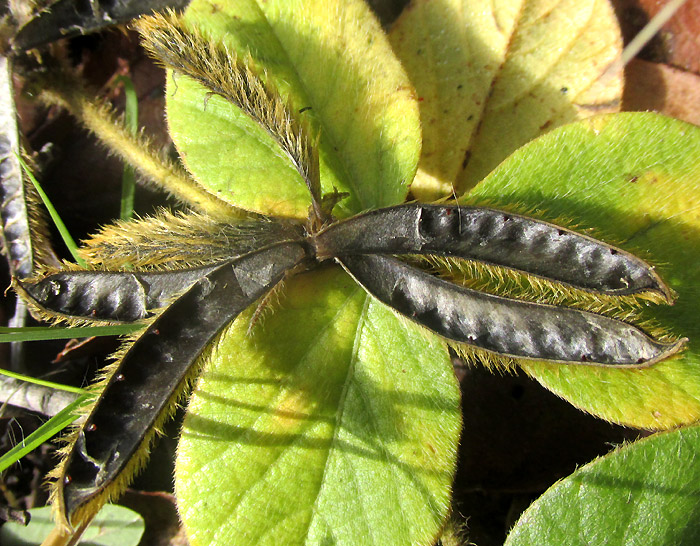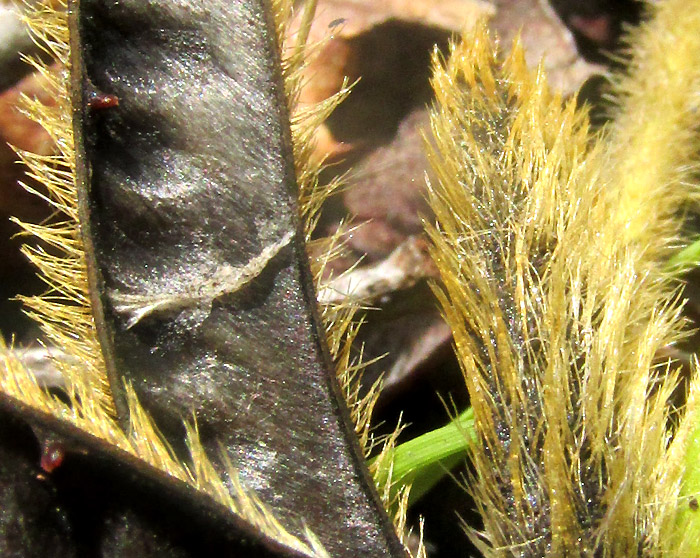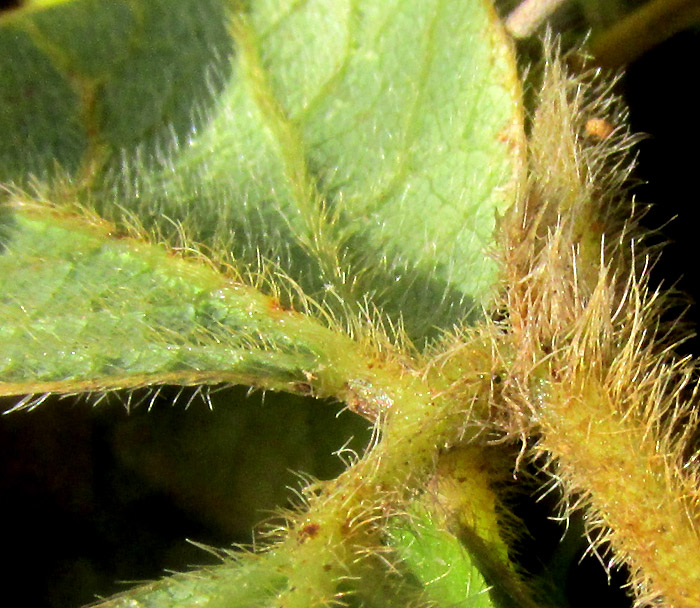Excerpts from Jim Conrad's
Naturalist Newsletter
Entry dated November 10, 2023, from notes taken from ridge with secondary oak forest about 300m west of Cascadas de La Piedad waterfall 3kms NW of the community of San Pablo, municipality of Almeaco de Bonfil; N20.1002°, W100.0067°, elevation 2360 meters (7750ft); extreme southern Querétaro state, MÉXICO
LEMMON'S COLOGANIA

At the woods' edge, beneath an oak accessible to morning sunlight pouring across the adjacent abandoned field, the above fruiting herb's stems lay on the ground, mostly hidden by fallen leaves. With compound leaves of three leaflets and legume-type fruits, it was a classic member of the big Bean Family, the Fabaceae.

The legumes already had split open, disseminating their seeds. Most technical identification needs flowers, but the outsides of the legumes' pods were so unusually shaggy with long, slightly rusty-colored hairs, and the hairy leaflets were so strikingly broad with rounded tips, that maybe naming the plant would be possible.

The long hairs were fairly straight but not particularly stiff. They bore no glands and their tips weren't hooked.

Beneath the leaflets' surfaces it was the same story.

Beyond that, now at the chilly end of a relatively rainless rainy season, the plants' leaves were drying up, turning yellow and falling off. The above view evoked nostalgic autumnal feelings for this displaced northerner, a feeling seldom encountered in the tropics, except here in the high mountains.
Mostly the individual legumes' stalkless nature and being gathered into small clusters atop a short peduncle disqualified most similar-looking genera. I made a lucky guess that this was a Cologania, and with the ground-hugging stems, the shaggy, tan hairiness and the leaflets' almost rounded shape, by comparing our plant with pictures of the five Cologania species occurring in Querétaro state, it was easy to recognize our plant as COLOGANIA OBOVATA.
In English wildflower publications, Cologania obovata is fairly consistently referred to as Lemmon's Cologania, because in 1883 the American Asa Gray named the species Cologania lemmonii, after J.G. Lemmon, who had collected the plant. However, earlier, in 1838, the German Diederich Franz Leonhard von Schlechtendal had named the same taxon Cologania obovata, from a plant collected nearby in Hidalgo state, and that name has precedence. Not far from our current location we've found another Cologania species, one that's more definitely a vine, is less hairy, and bearing much narrower leaflets, the Longleaf Cologania. That species produces large, intensely blue-violet flowers similar to those seen in pictures of our Lemmon's Cologania.
Cologania obovata is described as occurring in highland forests of various types, especially in forest clearings, and dry, scrubby areas, from the US southern borderlands with Mexico in Arizona state, south through the Western Sierra Madres, through the central Mexican highlands, to Oaxaca.
A 2009 study by Mexico's Durango state government, directed by Jesús Soto Rodríguez and entitled "Estudio Regional Forestal UMAFOR No. 1006 'San Dimas'," tells us that in the area of study the root of Cologania obovata is mashed in water used for bathing the newborn so that they don't become ill. Pigs like to eat the root, presumably rooting them up.